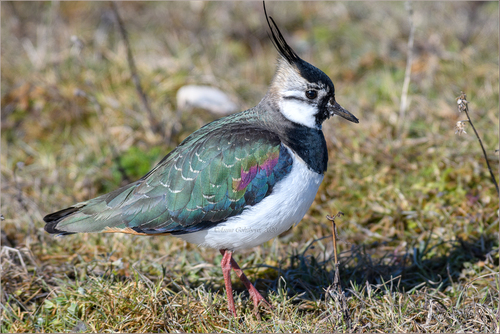
Northern Lapwing
The Northern Lapwing (*Vanellus vanellus*) is a striking wader bird, easily recognized by its iridescent black and white plumage, long crest, and broad, rounded wings. It plays a vital role in agricultural ecosystems, consuming a variety of invertebrates and contributing to pest control. Historically, the lapwing's eggs were considered a delicacy in some European cultures, leading to population declines in the past. This species is known for its distinctive, tumbling display flights and its evocative, peewit-like call, which has earned it the nickname "Peewit" in many regions.
28-33 cm
Length
67-87 cm
Wingspan
Near Threatened
Conservation Status
Distribution
The Northern Lapwing has a wide distribution across temperate Eurasia, from Western Europe to East Asia. It breeds across this range and migrates south for the winter, reaching North Africa, the Middle East, the Indian subcontinent, and parts of Southeast Asia. Its altitudinal range extends from sea level to upland areas, though it primarily favors lowlands.
Lifespan
The average lifespan in the wild is around 4-5 years, but individuals can live up to 10 years or more.
Northern Lapwing's Habitat
Habitat Types
Farmland, Grasslands, Wet meadows, Coastal marshes, Moorlands
Climate Zones
Temperate, Boreal
Adaptations
Northern Lapwings are adapted to open habitats, with their cryptic plumage providing camouflage on the ground. Their long legs allow them to wade in shallow water and forage in damp fields. They are relatively tolerant of human-modified landscapes, provided that suitable nesting and feeding areas are available.
Variations
While generally considered monotypic (no recognized subspecies), some minor variations in size and plumage darkness have been noted across the species' range, though these are not considered significant enough to warrant subspecific classification.
Appearance
Breeding Plumage
Breeding plumage features a glossy, iridescent black back, white underparts, and a long, thin crest. Non-breeding plumage is duller, with buff-tinged upperparts and a shorter crest.
Seasonal Feather Changes
The most significant seasonal variation is the change between breeding and non-breeding plumage, as described above. Juveniles have scaled upperparts and a shorter crest.
Sex Based Plumage Differences
Sexual dimorphism is subtle. Males generally have a slightly longer crest and a more intensely black breast band during the breeding season.
Notable Features
Long, thin crest, Broad, rounded wings, Iridescent black back (breeding plumage), White face with black markings
Diet and Feeding
Primary Foods
Insects, Earthworms, Spiders, Crustaceans, Mollusks, Seeds (occasionally)
Foraging Behavior
Northern Lapwings primarily forage by walking and pecking at the ground, visually searching for prey. They may also probe soft soil or mud with their bills. They are often seen foraging in loose flocks, particularly in fields.
Specializations
Their relatively long legs and bill are well-suited for foraging in short vegetation and shallow water. They have good eyesight for spotting prey.
Seasonal Diet Variations
During the breeding season, their diet consists mainly of insects and other invertebrates. In winter, they may consume more earthworms and, to a lesser extent, seeds, depending on availability.
Behavior
Social Structure
Northern Lapwings are often found in flocks, especially outside the breeding season. During breeding, they are territorial, defending their nesting area from other lapwings and potential predators.
Communication
Distinctive 'peewit' call, Variety of other calls, including alarm calls, Visual displays, such as wing flapping and crest raising
Migration
Many populations of Northern Lapwings are migratory, undertaking long-distance movements between breeding and wintering grounds. The timing and routes of migration vary depending on the population. Migration often occurs in large flocks.
Territorial or Group Behaviors
During the breeding season, males establish and defend territories through aerial displays and aggressive encounters with rivals. Outside the breeding season, they are more gregarious and form flocks.
Conservation
Threats
Habitat loss and degradation (due to agricultural intensification, drainage of wetlands, and afforestation), Changes in farming practices (e.g., earlier mowing dates, increased use of pesticides), Predation (by foxes, crows, and other predators), Climate change (potentially affecting breeding success and migration patterns)
Protection Programs
Agri-environment schemes (in Europe, aimed at promoting lapwing-friendly farming practices), Habitat restoration and management projects, Monitoring programs
Local National Laws
Protected under various national and international legislation, including the EU Birds Directive.
Population Trend
Decreasing
Population Estimates
The global population is estimated to be 5.2 - 7.6 million mature individuals, but significant declines have been observed in many parts of its range.
Interesting Facts
Northern Lapwings are known for their 'broken wing' display.
When a predator approaches the nest, the adult bird will often feign injury, dragging a wing along the ground to lure the predator away from the eggs or chicks.
Their flight is characterized by erratic, tumbling movements.
This distinctive flight style, combined with their broad, rounded wings, makes them easily identifiable in the air.
The name 'lapwing' refers to the flapping sound of their wings in flight.
This is an onomatopoeic name, reflecting the characteristic sound they produce.
Faqs about Northern Lapwing
What is the collective noun for lapwings?
A group of lapwings is called a 'deceit'.
Are lapwings endangered?
The Northern Lapwing is currently classified as Near Threatened by the IUCN. While not yet considered endangered, its population is declining, and it faces significant threats.
Where can I see Northern Lapwings?
Look for them in open habitats such as farmland, grasslands, and wetlands, particularly during the breeding season. Check local birdwatching guides or online resources for specific locations in your area.
Do Northern Lapwings migrate every year?
Yes, many populations are migratory, undertaking significant journeys between their breeding and wintering grounds. However, some populations in milder climates may be resident or only partially migratory.
Copyright @ Nature Style Limited. All Rights Reserved.
 English
English